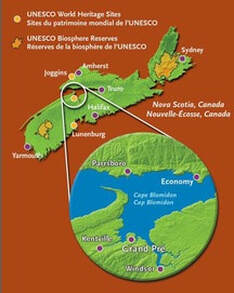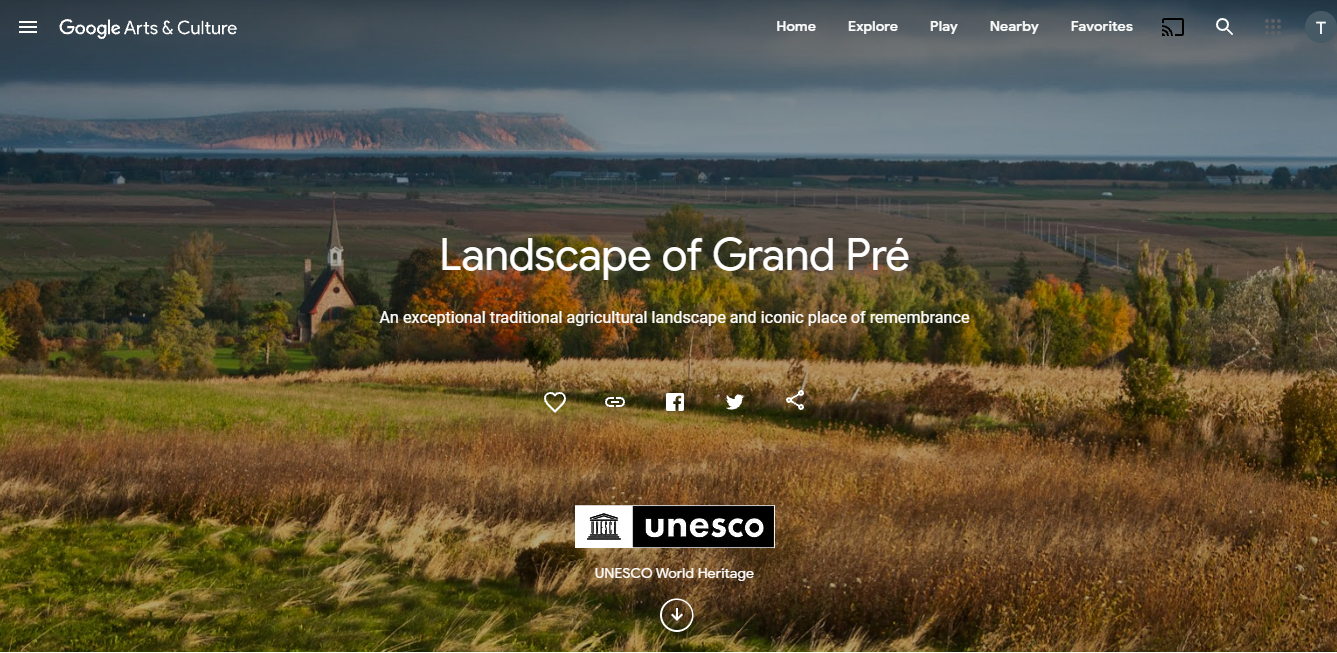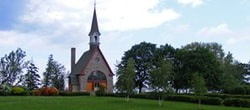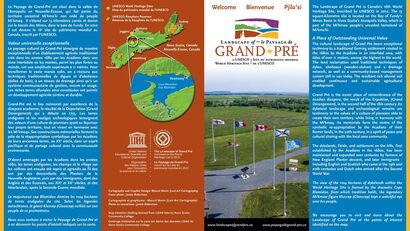Landscape of Grand Pré
Nova Scotia
To mark the 10th anniversary of the Landscape of Grand-Pré becoming a UNESCO World Heritage site, Nova Scotia will celebrate the rich heritage of this landscape which features an exceptional traditional agricultural settlement still in use today and an iconic place of memory for the Acadian diaspora. On June 30th, 2012, the Landscape of Grand-Pré became Canada’s 16th World Heritage Site, listed by UNESCO and 2022 will mark its 10th year anniversary.
Live WebCam of Grand Pré View Park
|
|
Facing North - from the View Park towards the expanse of dykelands of the World Heritage Site. To the east and west are dykes protecting the active agricultural landscape. The Memorial Church at Grand-Pré National Historic Site can be seen in the middle distance; Long Island is to the north of the dykelands and the cliffs of Blomidon are in the far distance. |
What is a UNESCO World Heritage Site?
Heritage is our legacy from the past, what we live with today, and what we pass on to future generations. Our cultural and natural heritage are both irreplaceable sources of life and inspiration. The United Nations Educational, Scientific and Cultural Organization (UNESCO) seeks to encourage the identification, protection and preservation of cultural and natural heritage around the world considered to be of outstanding value to humanity. This is embodied in an international treaty, the Convention concerning the Protection of the World Cultural and Natural Heritage, adopted by UNESCO in 1972.
|
UNESCO World Heritage Sites have cultural and/or natural significance which is so exceptional as to transcend national boundaries and to be of common importance for present and future generations to come.
The Outstanding Universal Value of this remarkable agricultural and symbolic landscape is captured below:
The Landscape of Grand Pré is an exceptional living agricultural landscape, claimed from the sea in the 17th century and still in use today applying the same technology and the same community-based management. Grand Pré is also the iconic place of remembrance of the Acadians who lived in harmony with the native Mi’Kmaq people before the Expulsion which began in 1755. Its memorial constructions form the centre of the symbolic re-appropriation of the land of their origins by the Acadians, in the 20th century, in a spirit of peace and cultural sharing with the local area community. Please see UNESCO for the approved and complete statement of Outstanding Universal Value. |
Who is the Landscape of Grand Pré Inc.?

Landscape of Grand Pré Inc. is a not-for-profit organisation, created on January 22, 2016, under the Canada Not-for-profit Corporations Act with its stated purposes to:
- To protect and preserve the Landscape of Grand Pré UNESCO World Heritage Site, in Grand Pré, Nova Scotia;
- To educate the public and increase its appreciation and awareness of the Landscape of Grand Pré UNESCO World Heritage Site and its history.
10 years as a UNESCO World Heritage Site
Google Arts & Culture
Google Arts & Culture recently featured the Landscape of Grand Pré World Heritage Site in collaboration with Parks Canada.
|
Discover. Learn. Enjoy.
The dykelands, fields, and settlement on the hills, first established by the Acadians in the 1680s, have been maintained and expanded over centuries by farmers of New England Planter descent, and later immigrants - including English and Scottish who came in the 19th and 20th centuries and Dutch who arrived after the Second World War.
|
Agricultural Excellence
Here at Grand-Pré, as elsewhere in Acadie, the Acadians established their settlements to take advantage of the potentially fertile salt marshes. In fact, no other people in North America developed agricultural communities as extensively as the Acadians did by transforming intertidal zones with the use of aboiteau technology.
|
History and Development
The incredible Grand Pré is steeped in historical relevance. Since the 1680s, when a small group of Acadian settlers first arrived in the area and called the vast wetlands la grand pré (The Big Meadow) the human history of Grand Pré has been linked to its natural setting and the exceptional fertility of this land fertile agricultural land by the sea.
|








